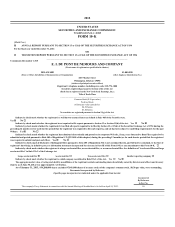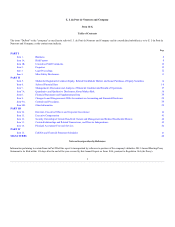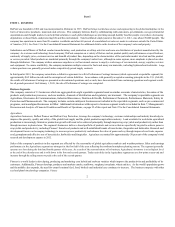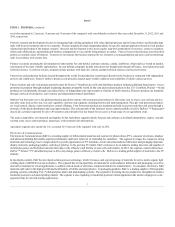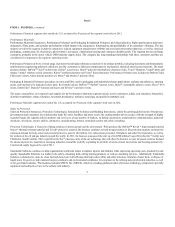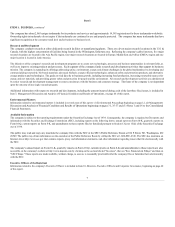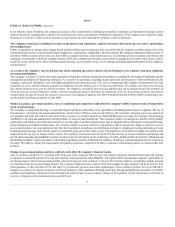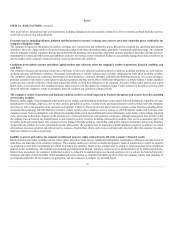DuPont 2012 Annual Report Download - page 11
Download and view the complete annual report
Please find page 11 of the 2012 DuPont annual report below. You can navigate through the pages in the report by either clicking on the pages listed below, or by using the keyword search tool below to find specific information within the annual report.
continued
other trade barriers. International risks and uncertainties, including changing social and economic conditions as well as terrorism, political hostilities and war,
could lead to reduced sales and profitability.
The company is exposed to fluctuations in currency exchange rates, interest rates and commodity prices. Because the company has significant international
operations, there are a large number of currency transactions that result from international sales, purchases, investments and borrowings. The company
actively manages currency exposures that are associated with net monetary asset positions, committed currency purchases and sales, foreign currency-
denominated revenues and other assets and liabilities created in the normal course of business. Failure to successfully manage these risks could have an
adverse impact on the company's financial position, results of operations and cash flows.
The company's business and operating results may in the future be adversely affected by global economic conditions, including instability in credit markets,
declining consumer and business confidence, fluctuating commodity prices, volatile exchange rates, and other challenges that could affect the global economy.
The company's customers may experience deterioration of their businesses, cash flow shortages, and difficulty obtaining financing. As a result, existing or
potential customers may delay or cancel plans to purchase products and may not be able to fulfill their obligations in a timely fashion. Further, suppliers
could experience similar conditions, which could impact their ability to fulfill their obligations to the company. Adversity within capital markets may impact
future return on pension assets, thus resulting in greater future pension costs that impact the company's results. Future weakness in the global economy could
adversely affect the company's results of operations, financial condition and cash flows in future periods.
Business and/or supply chain disruptions, plant and/or power outages and information technology system and/or network disruptions, regardless of cause
including acts of sabotage, employee error or other actions, geo-political activity, weather events and natural disasters could seriously harm the company's
operations as well as the operations of its customers and suppliers. Failure to effectively prevent, detect and recover from security breaches, including attacks
on information technology and infrastructure by hackers; viruses; breaches due to employee error or actions; or other disruptions could result in misuse of the
company's assets, business disruptions, loss of property including trade secrets and confidential business information, legal claims or proceedings, reporting
errors, processing inefficiencies, negative media attention, loss of sales and interference with regulatory compliance. Although management does not believe that
the company has experienced any material losses to date related to security breaches, including cybersecurity incidents, there can be no assurance that it will
not suffer such losses in the future. The company actively manages the risks within its control that could lead to business disruptions and security breaches.
As these threats continue to evolve, particularly around cybersecurity, the company may be required to expend significant resources to enhance its control
environment, processes, practices and other protective measures. Despite these efforts, such events could materially adversely affect the company's business,
financial condition or results of operations.
Intellectual property rights, including patents, plant variety protection, trade secrets, confidential information, trademarks, tradenames and other forms of
trade dress, are important to the company's business. The company endeavors to protect its intellectual property rights in jurisdictions in which its products
are produced or used and in jurisdictions into which its products are imported. However, the company may be unable to obtain protection for its intellectual
property in key jurisdictions. The company has designed and implemented internal controls to restrict access to and distribution of its intellectual property.
Despite these precautions, the company's intellectual property is vulnerable to unauthorized access through employee error or actions, theft and cybersecurity
incidents, and other security breaches. When unauthorized access and use or counterfeit products are discovered, the company reports such situations to
governmental authorities for investigation, as appropriate, and takes measures to mitigate any potential impact.
10

